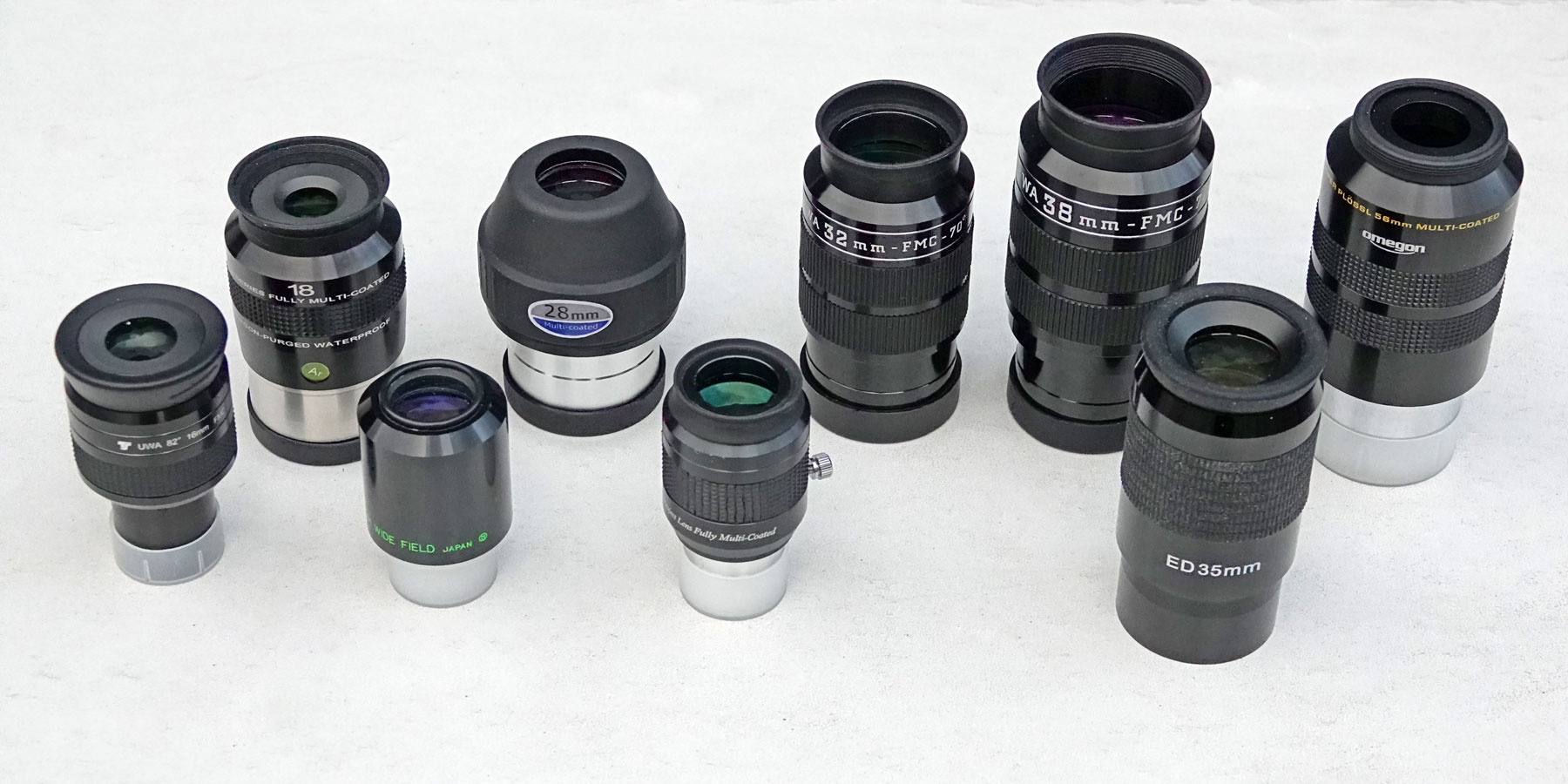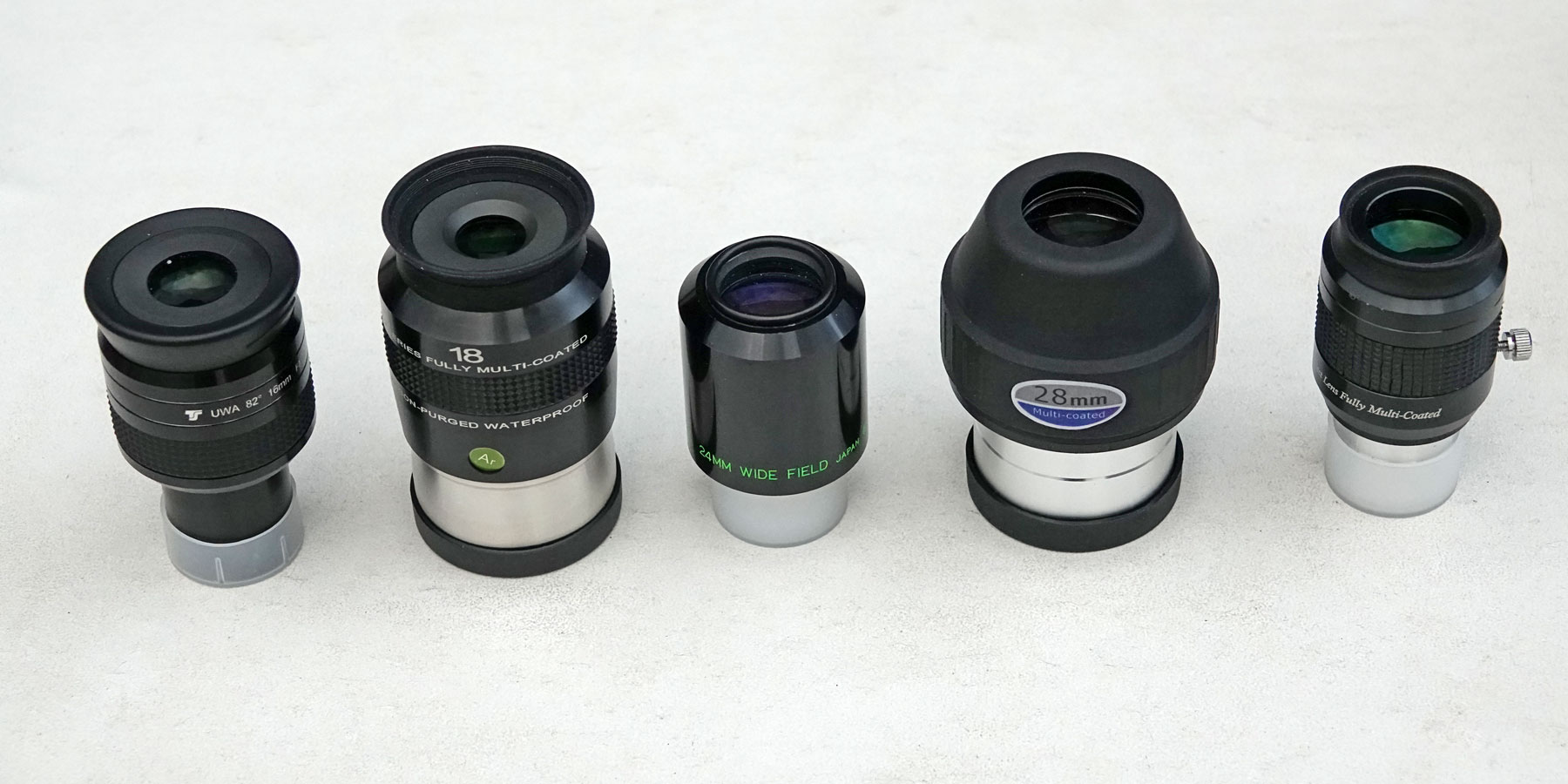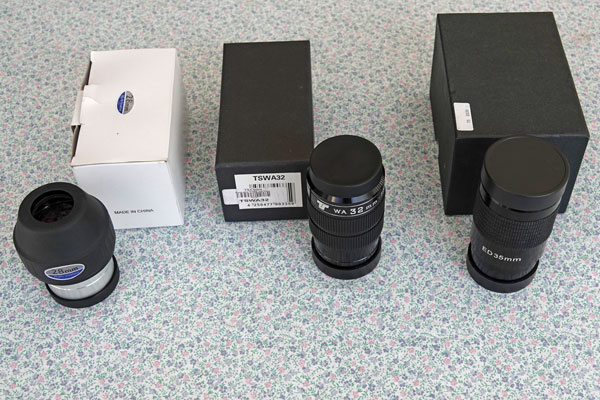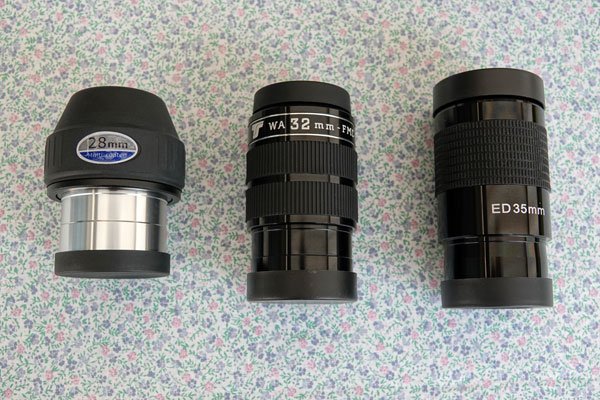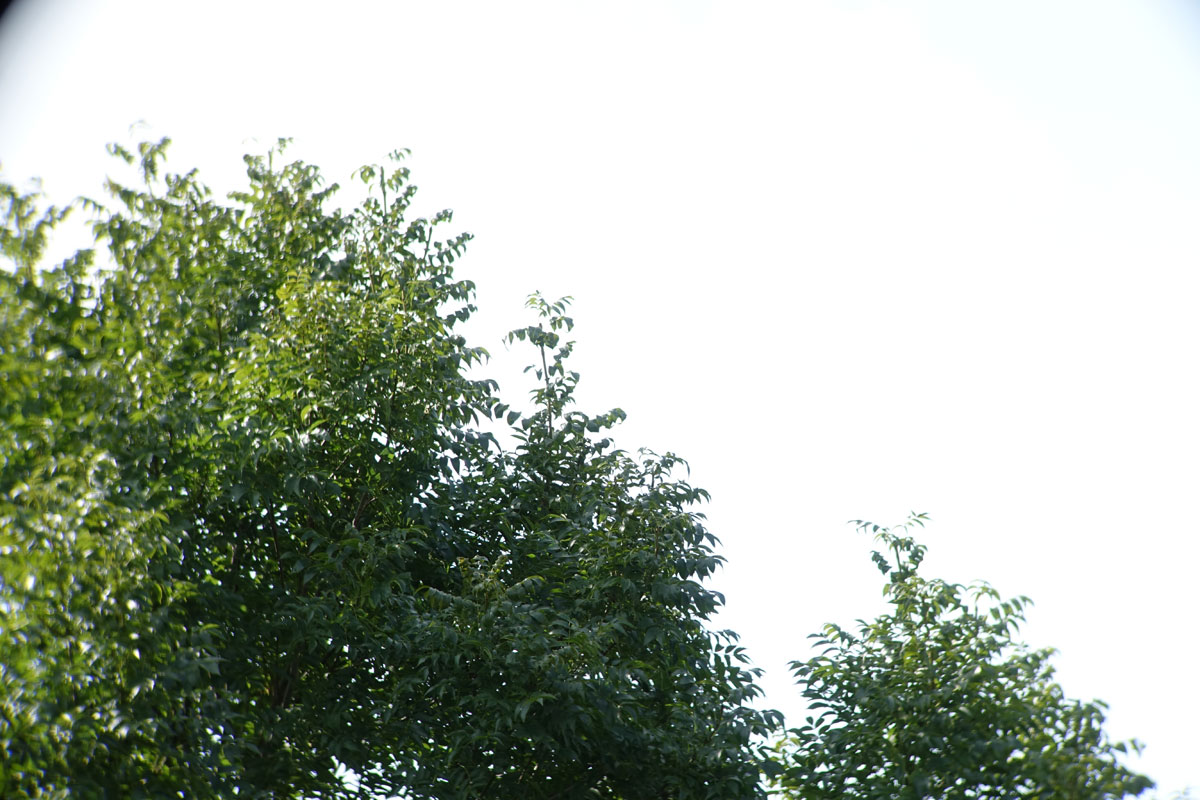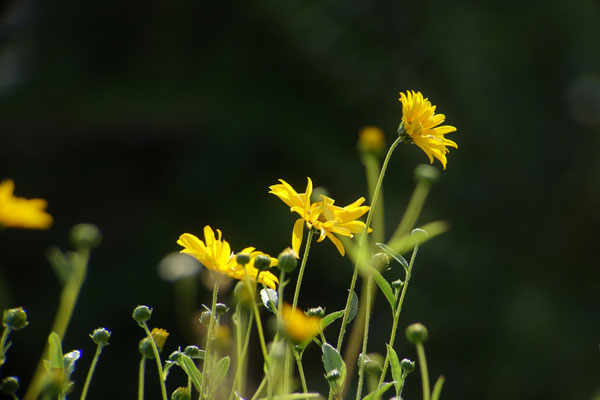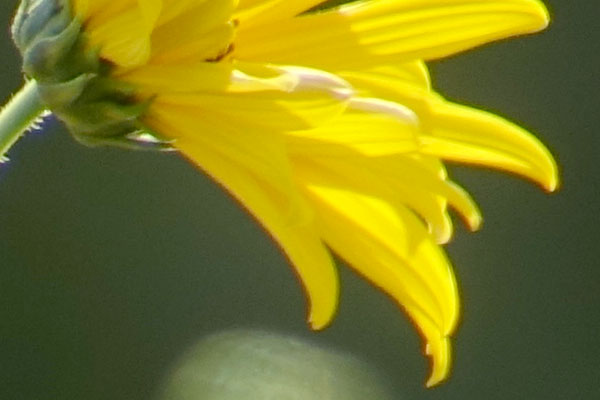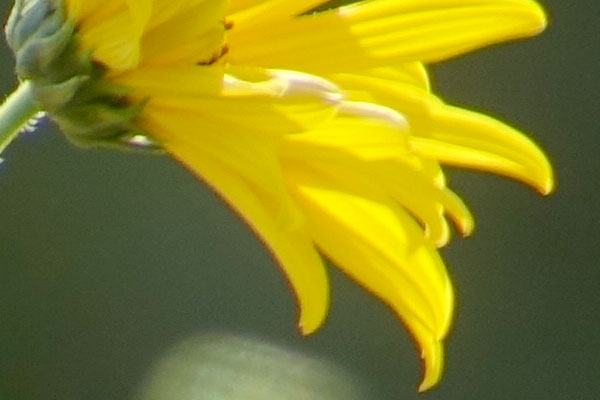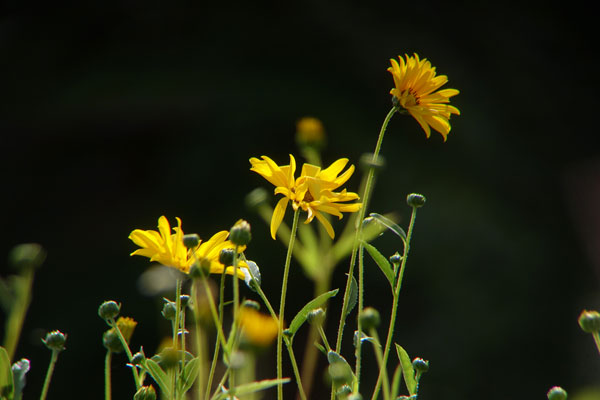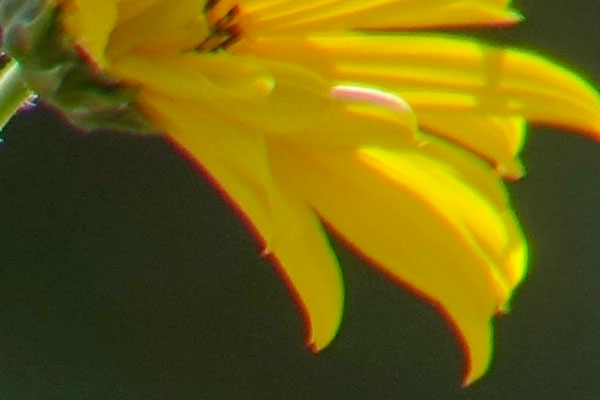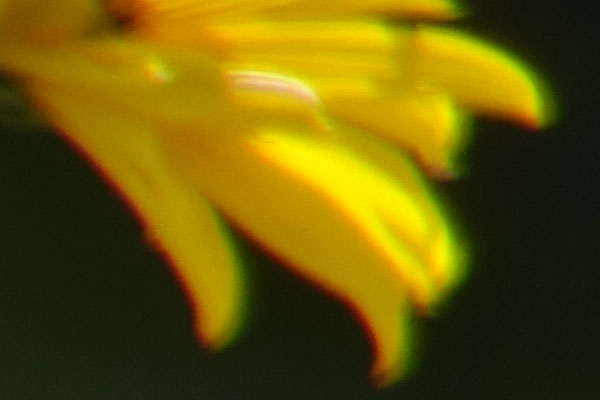Eyepiece Comparison 2019
Introduction | Comparisons in Daylight | Comparisons by Night | Conclusions | Links | Appendix: Brief Comparison of TSWA32 and TSED35 Eyepieces
On this page, I report on an informal eyepiece comparison that I did in November and December 2019. Primarily it was about using 2" eyepieces on my new Celestron C8 telescope. A starfriend lent me four of his 2" eyepieces because he did not need them for some time. In addition, there were two of my 2" eyepieces and some 1.25" eyepieces from my "collection" that matched some of the 2" eyepieces. Unfortunately, the sky was mostly cloudy at night or we were not at home. So I did a lot of the testing during the day, partly with my refractor PS 72/432, and also while traveling. The daytime comparisons with the C8 and PS 72/432 showed approximately the same results, so that I think that the use of the refractor in these comparisons is acceptable. Thereafter, I was able to carry out tests at night on the crescent and half moon.
I would like to emphasize that I consider myself as a layman in the evaluation of eyepieces and only report on my subjective impressions here.
Note: See also the appendix offering a Brief Comparison of TSWA32 and TSED35 Eyepieces.
Introduction
I used the following eyepieces for the comparison:
- 16 mm UWA (1.25", 82°) > for a comparison with the Explore Scientific 18 mm eyepiece (2", 82°)
- 18 mm Explore Scientific wide angle eyepiece (2", 82°) - borrowed
- 24 mm TeleVue WA (1.25", 65°) > for a comparison with the Sky-Watcher LET 28 mm eyepiece (2", 56°)
- 28 mm Sky-Watcher LET (2", 56°)
- 32 mm DigiScope Plössl (1.25", 52°) >for a comparison with the TSWA 32 mm eyepiece (2", 70°); has about the same of view as the 28 mm LET
- 32 mm TSWA eyepiece (2", 70°) - borrowed
- 35 mm TSED (2", 69 °) > for a comparison with the TSWA 32 mm eyepiece (2", 70 °) and the TSWA 38 mm eyepiece (2", 70°)
- 38 mm TSWA eyepiece (2", 70°) - borrowed
- 56 mm Omegon Super Plössl eyepiece (2", 52°) - borrowed, bought, and sold back (that is, borrowed)
Photos of the Eyepieces
Photo: All eyepieces that were used in the comparison - TS 16 mm UWA, Explore Scientific 18 mm UWA, TeleVue 24 mm WA, Sky-Watcher 28 mm LET, 32 mm DigiScope Plössl, TSWA32 32 mm WA, TSWA38 38 mm WA, TSED35 35 mm WA, Omegon 56 mm Super Plössl
Photo: The eyepieces with a shorter focal length - TS 16 mm UWA, Explore Scientific 18 mm UWA, TeleVue 24 mm WA, Sky-Watcher 28 mm LET, 32 mm DigiScope Plössl (has about the same field of view as the 28 mm LET and the 24 mm TeleVue)
Photo: The eyepieces with a shorter focal length - 32 mm DigiScope Plössl, TSWA32 32 mm WA, TSED35 35 mm WA, TSWA38 38 mm WA, Omegon 56 mm Super Plössl
Visual Power (Magnification) and other Data for Different Focal Lengths of Eyepieces
Visual Power (Magnification) and other Data for Different Focal Lengths of Eyepieces
Note: These tables include the StarTravel 120 refractor*, a TSWA32 eyepiece (2", 32 mm focal length, 70° viewing angle) that I borrowed together with the StarTravel 120, a 18 mm eyepiece (2", 82° viewing angle), a 38 mm eyepiece (2", 70° viewing angle), and a 56 mm eyepiece (2", 52° viewing angle).
I did not include the Celestron 25 mm Plössl eyepiece which is packaged with the C8, because I will probably give it away...
*) I had compared the TSWA32 and TSED35 eyepieces using this telescope in the fall of 2019; it was not involved in this comparison, because I had returned it already.
| Telescope | Further Data |
Focal Length of Eyepiece (mm) |
|||||||||||||
| Magnification | |||||||||||||||
Focal Length of Telescope (mm) |
4 |
7 |
10 |
16 |
18 |
24 |
26 |
28 |
32 |
32 |
35 |
38 |
40 |
56 |
|
| PS 72/432 | 432 |
108.00 |
61.71 |
43.20 |
27.00 |
24.00 |
18.00 |
16.62 |
15.43 |
13.50 |
13.50 |
12.34 |
11.37 |
10.80 |
7.71 |
| ST120 | 600 |
150.00 |
85.71 |
60.00 |
37.50 |
33.33 |
25.00 |
23.08 |
21.43 |
18.75 |
18.75 |
17.14 |
15.79 |
15.00 |
10.71 |
| TLAPO1027 | 714 |
178.50 |
102.00 |
71.40 |
44.63 |
39.67 |
29.75 |
27.46 |
25.50 |
22.31 |
22.31 |
20.40 |
18.79 |
17.85 |
12.75 |
| 150PDS | 750 |
187.50 |
107.14 |
75.00 |
46.88 |
41.67 |
31.25 |
28.85 |
26.79 |
23.44 |
23.44 |
21.43 |
19.74 |
18.75 |
13.39 |
| Skymax-127 | 1500 |
375.00 |
214.29 |
150.00 |
93.75 |
--- |
62.50 |
--- |
--- |
46.88 |
--- |
--- |
--- |
--- |
--- |
| Skymax-102 | 1300 |
325.00 |
185.71 |
130.00 |
81.25 |
--- |
54.17 |
--- |
--- |
40.63 |
--- |
--- |
--- |
--- |
--- |
| C5 | 1250 |
312.50 |
178.57 |
125.00 |
78.13 |
69.44 |
52.08 |
48.08 |
44.64 |
39.06 |
39.06 |
35.71 |
32.89 |
31.25 |
22.32 |
| C5 (Red.) | 787.5 |
196.88 |
112.50 |
78.75 |
49.22 |
--- |
32.81 |
30.29 |
--- |
24.61 |
--- |
22.50 |
--- |
19.69 |
--- |
| C8 | 2032 |
508.00 |
290.29 |
203.20 |
127.00 |
112.89 |
84.67 |
78.15 |
72.57 |
63.50 |
63.50 |
58.06 |
53.47 |
50.80 |
36.29 |
| C8 (Red.) | 1280 |
320.00 |
182.86 |
128.00 |
80.00 |
--- |
53.33 |
49.23 |
--- |
40.00 |
--- |
36.57 |
--- |
32.00 |
--- |
| True Field of View (°) | |||||||||||||||
Apparent Field
of View (°) > |
82 |
82 |
72 |
82 |
82 |
65 |
70 |
56 |
52 |
70 |
69 |
70 |
68 |
52 |
|
Focal Length of Telescope (mm) |
4 |
7 |
10 |
16 |
18 |
24 |
26 |
28 |
32 |
32 |
35 |
38 |
40 |
56 |
|
| PS 72/432 | 432 |
0.76 |
1.33 |
1.67 |
3.04 |
3.42 |
3.61 |
4.21 |
3.63 |
3.85 |
5.19 |
5.59 |
6.16 |
6.30 |
6.74 |
| ST120 | 600 |
0.55 |
0.96 |
1.20 |
2.19 |
2.46 |
2.60 |
3.03 |
2.61 |
2.77 |
3.73 |
4.03 |
4.43 |
4.53 |
4.85 |
| TLAPO1027 | 714 |
0.46 |
0.80 |
0.91 |
1.84 |
2.07 |
2.18 |
2.55 |
2.20 |
2.33 |
3.14 |
3.38 |
3.73 |
3.92 |
4.08 |
| 150PDS | 750 |
0.44 |
0.77 |
0.96 |
1.75 |
1.97 |
2.08 |
2.43 |
2.09 |
2.22 |
2.99 |
3.22 |
3.55 |
3.63 |
3.88 |
| Skymax-127 | 1500 |
0.22 |
0.38 |
0.48 |
0.87 |
--- |
1.04 |
--- |
--- |
1.11 |
--- |
--- |
--- |
--- |
--- |
| Skymax-102 | 1300 |
0.25 |
0.44 |
0.55 |
1.01 |
--- |
1.20 |
--- |
--- |
1.28 |
--- |
--- |
--- |
--- |
--- |
| C5 | 1250 |
0.26 |
0.46 |
0.58 |
1.05 |
1.18 |
1.25 |
1.46 |
1.25 |
1.33 |
1.79 |
1.93 |
2.13 |
2.18 |
2.33 |
| C5 (Red.) | 787.5 |
0.42 |
0.73 |
0.91 |
1.67 |
--- |
1.98 |
2.31 |
--- |
2.11 |
--- |
3.07 |
--- |
3.45 |
--- |
| C8 | 2032 |
0.16 |
0.28 |
0.35 |
0.65 |
0.73 |
0.77 |
0.90 |
0.77 |
0.82 |
1.10 |
1.19 |
1.31 |
1.34 |
1.43 |
| C8 (Red.) | 1280 |
0.26 |
0.45 |
0.63 |
1.03 |
--- |
1.22 |
1.42 |
--- |
1.30 |
--- |
1.89 |
--- |
2.13 |
--- |
| Exit Pupil (mm) | |||||||||||||||
Focal Ratio |
4 |
7 |
10 |
16 |
18 |
24 |
26 |
28 |
32 |
32 |
35 |
38 |
40 |
56 |
|
| PS 72/432 | 6 |
0.67 |
1.17 |
1.67 |
2.67 |
3.00 |
4.00 |
4.33 |
4.67 |
5.33 |
5.33 |
5.83 |
6.33 |
6.67 |
9.33 |
| ST120 | 5 |
0.80 |
1.40 |
2.00 |
3.20 |
3.60 |
4.80 |
5.20 |
5.60 |
6.40 |
6.40 |
7.00 |
7.60 |
8.00 |
11.20 |
| TLAPO1027 | 7 |
0.57 |
1.00 |
1.43 |
2.29 |
2.57 |
3.43 |
3.71 |
4.00 |
4.57 |
4.57 |
5.00 |
5.43 |
5.71 |
8.00 |
| 150PDS | 5 |
0.80 |
1.40 |
2.00 |
3.20 |
3.60 |
4.80 |
5.20 |
5.60 |
6.40 |
6.40 |
7.00 |
7.60 |
8.00 |
11.20 |
| Skymax-127 | 11.81 |
0.34 |
0.59 |
0.85 |
1.35 |
--- |
2.03 |
--- |
--- |
2.71 |
--- |
--- |
--- |
--- |
--- |
| Skymax-102 | 12.75 |
0.31 |
0.55 |
0.78 |
1.26 |
--- |
1.88 |
--- |
--- |
2.51 |
--- |
--- |
--- |
--- |
--- |
| C5 | 10 |
0.40 |
0.70 |
1.00 |
1.60 |
1.80 |
2.40 |
2.60 |
2.80 |
3.20 |
3.20 |
3.50 |
3.80 |
4.00 |
5.60 |
| C5 (Red.) | 6.3 |
0.63 |
1.11 |
1.59 |
2.54 |
--- |
3.81 |
4.13 |
--- |
5.08 |
--- |
5.56 |
--- |
6.35 |
--- |
| C8 | 10 |
0.40 |
0.70 |
1.00 |
1.60 |
1.80 |
2.40 |
2.60 |
2.80 |
3.20 |
3.20 |
3.50 |
3.80 |
4.00 |
5.60 |
| C8 (Red.) | 6.3 |
0.63 |
1.11 |
1.59 |
2.54 |
--- |
3.81 |
4.13 |
--- |
5.08 |
--- |
5.56 |
--- |
6.35 |
--- |
Blue: Equipment borrowed for comparison purposes; gray: sold equipment; italic: 2" eyepieces
Magnification: Yellow: low (30-50 x); magenta: medium
(80-100 x); violet: high (150-200 x - and more); red: beyond
maximum usable magnification.
Exit pupil: Values in magenta cells are
either too small (< 1 mm) or too large (> 6.4/7 mm); yellow background:
best for galaxies (about 2-3 mm).
Comparisons in Daylight
I describe the following comparisons in "telegram style." I did not take any photos of what I saw in the eyepieces, describe my subjective qualitative impressions only with words.
Comparisons Using the Omegon PS 72/432
On November 21, 2019, I compared the eyepieces presented above using my Omegon PS 72/432 refractor.
TS UWA 16 mm (1.25") versus Explore Scientific 18 mm Wide Angle (2") - About the Same Magnification/Field of View
- 16 mm: Dull view, but it was a dull and cloudy day, good looking; the blue color fringes at the edges of the field of view were less disturbing and smaller than with the ES18; small yellow and blue color fringes at edges, becoming stronger towards the edges of the field of view; pin cushion distortion at the edges of the field of view, becoming stronger towards the edges of the field of view.
- 18 mm: The view was "narrow," it looked like a "tunnel
view" to me > the field
of view was "Plössl-like"; only when I moved my eye very
close to the eyepiece, the field of view became large, otherwise I had
to look around the corner to exploit the field of view; at the edges of
the field of view, wide yellow and blue color fringes appeared; small yellow
and blue color fringes appeared at edges - already in the middle, these
were increasing in
the edges of the field of view; altogether, the 18 mm eyepiece exhibited
much stronger color fringes than the 16 mm one; pin cushion distortion
at the edges of the field of view - perhaps not as strong as with the 16
mm eyepiece...
> This eyepiece is being advertised as having a "very comfortable eye relief also suitable for spectacle wearers"; unfortunately, I cannot confirm this...
TeleVue WA 24 mm (1,25") versus Sky-Watcher LET 28 mm (2") - Identical Field of View
- 24 mm: yellow fringes at the edges of the field of view; distinct pin cushion distortion towards the edges (easily visible when moving), larger apparent image field than the 28 mm LET; blurred at the edges of the field of view, can be focused ("image field curvature")
- 28 mm: Very fine cyan/green fringes at the edges of the field of view, hardly/not at all pin cushion distortion; blurred at the edges of the field of view, can be focused ("image field curvature"); smaller image field, perhaps better to oversee, nice view
Omegon Super Plössl 56 mm (2")
- 56 mm: Very small apparent field of view, the "tunnel vision" needs getting used to, if you are used to a larger field of view... Looking OK, I found neither distortions nor color errors ; unusual focus position (far away from infinity...).
- 56 mm versus LET 28 mm: The LET had a much larger field of view and offered twice the magnification.
DigiScope Plössl 32 mm (1,25") versus TSWA32 32 mm (2") - Two 32 mm Eyepieces
- DS32 mm: no or very little distortion; magenta color fringes at the edges, but not conspicuous; clear image, small field of view
- TSWA32 mm: Larger field of view; distinct red and blue color fringes towards the edges of the field of view, at the edges of the field of view blurred ("field curvature"), hardly any distortions; cyan ring at the sharp edges of the field of view, only visible when getting close, because I did not see the field of view completely with the eyecup (therefore I did not see the fine cyan border line at first).
TSWA32 (32 mm, 2") versus TSED35 (35 mm, 2") versus TSWA38 (38 mm, 2") - the Long Ones...
- TSWA32: Not a huge difference in the field of view to the TSED35, but present; clearly more conspicuous color fringes than the 35, which is more pleasant (the difference became very clear on branches, for example).
- TSED35: Fuzzy edges of the field of view, green, I also do not have a complete overview of the field of view; no/very little distortion; color fringes otherwise hardly noticeable, but present in purple at edges, becoming stronger to the edges, but much less disturbing than with the TSWA32.
- TSWA38: Increasingly red color fringes towards the edges, but less strong than with the TSWA32; the field of view was also large and not completely overseeable at the edges, fine cyan ring at the edges of the field of view, stronger "field curvature", in the corners more blurred???; becomes much more blurred towards the edges compared with the TSED35 (the TSWA32 behaves this way as well); the TSWA32/38 eyepieces are not homofocal!
- Further tests on the field of view using a roof with an antenna and trees; when using the antenna, I saw the difference in the field of view more pronounced; the TSWA eyepieces showed a slight red border at the end of the antenna (some other eyepieces did so as well), the TSED35 not.
- 56 mm vs. TSWA38 (38 mm): I was able to see small differences in the field of view, but the 38 mm eyepiece's view is "blown up" compared to the one in the 56 mm eyepiece (the view is brighter in the latter).
- Conclusion: According to my experience in France, you will not see many differences in the color fringes at night. The differences in the field of view between the 32 mm, 35 mm and 38 mm eyepieces can be recognized, but are rather negligible during the day; the 56 mm eyepiece does not show a discernible difference to the 38 mm eyepiece with respect to i the the field of view, but a smaller and brighter image; the depth of field of the 56 mm eyepiece is also larger.
Brief Conclusion
After this first daylight test, the 56 mm eyepiece did not recommend itself for me, and the 35 ED was in my opinion superior to the two TSWA eyepieces (32/38 mm). Only the AP is better on the 32 when observing with the ST120 and the Explorer 150PDS. I did not like at all the 18 mm eyepiece from Explore Scientific when observing in daylight and got a very short eye relief, even though the advertising states otherwise.
Comparisons Using the Celestron C8
On November 22, 2019, I compared the eyepieces presented above with the Celestron C8. Due to the long focal length of the C8 the field of view is much smaller and the magnification much higher than on the PS 72/432.
TS UWA 16 mm (1,25") versus Explore Scientific 18 mm (2") - About the Same Magnification/Field of View
- 16 mm: Look fairly good (with the PS72, it seemed better to me .....), but the field of view could not to be fully overseen; blue color fringes at the edges of the field of view, but less disturbing and smaller than with the ES18; small yellow and violet color fringes at edges, becoming stronger towards the edges of the field of view; pin cushion distortion in the edges of the field of view, becoming stronger towards the edges.
- 18 mm: Look "narrow", looked like a "tunnel view" to me > the field of view was "Plössl-like"; only when I got very close did the field of view become large, otherwise I had to look around the corner to exploit the field of view; at the edges of the field of view wide yellow and blue color fringes; small violet and green/cyan color fringes at edges - already in the middle of the field of view, towards the edges increasing; altogether much stronger color fringes than the 16 mm; pin cushion distortion in the edges of the field of view, increasing towards the edges of the field of view.
TeleVue WA 24 mm (1,25") versus Sky-Watcher LET 28 mm (2") - Identical Field of View
- 24 mm: Fine yellow border at the edge of the field of view, increasingly yellow and violet color fringes towards the edges of the field of view; distinct pin cushion distortion towards the edges of the field of view (easily recognizable when moving), larger apparent field of view than the 28 mm LET; "image field curvature" not as clearly recognizable at the higher magnification of the C8.
- 28 mm: Very fine cyan/green edges of the field of view; red color fringes already in the center of the field of view, but small; hardly any pin cushion distortion; "image field curvature" not that noticeable at the higher magnification of the C8; smaller field of view, perhaps better to oversee, beautiful image?
Omegon Super Plössl 56 mm (2")
- 56 mm: Very small apparent field of view, the "tunnel vision" needs getting used to, if you are used to a larger field of view... Look OK, I did not discover any distortions and color errors; unusual focus position (far away from infinity), mirror shadow is noticeable
- 56 mm versus LET 28 mm: The LET has a significantly larger field of view and offers twice the magnification.
DigiScope Plössl 32 mm (1,25") versus TSWA32 32 mm (2") - Two 32 mm Eyepieces
- DS32 mm: No or hardly any distortion (towards the edges of the field of view somewhat, small), magenta color fringes at the edges of the field of view, but not conspicuous; clear image, small field of view >>field of view more like as with the 28 mm eyepiece (I did not notice this with the refractor; it is slightly larger according to data...)!
- TSWA32 mm: Larger field of view, distinct red and blue color fringes towards the edges of the field of view, "field curvature" not that visible at the higher magnification of the C8; hardly any distortions, slightly towards the edges of the field of view; cyan ring at the sharp edges of the field of view, only visible if you get close, because I did not oversee the field of view completely with eye caps (that is why I did not see the fine edges at first).
TSWA32 (32 mm, 2") versus TSED35 (35 mm, 2") versus TSWA38 (38 mm, 2") - the Long Ones...
- TSWA32: Not a huge difference in field of view to the TSED35, but present; clearly more conspicuous color fringes than the 35,which is more pleasant (the difference became very clear on branches, for example).
- TSED35: Fuzzy edges of the field of view, green, I also did not have a complete overview of the field of view; no/very little distortion, color fringes otherwise hardly noticeable, but present in purple at edges, becoming stronger to the edges of the field of view, but much less disturbing than with the TSWA32.
- TSWA38: Red color fringes, increasing towards the edges of the field of view, but less strong than with the TSWA32; the field of view was also large and not quite overseeable at the edges of the field of view, fine cyan edge of the field of view, "field curvature" not that visible at the higher magnification of the C8; the TSWA32/38 eyepieces are not homofocal!
- I did further tests on the field of view using a house facade; there, I saw the differences in the field of view more clearly.
- 56 mm vs. TSWA38 (38 mm): I was able to see a small difference in the field of view, which is "blown up " in the 38 mm eyepiece compared to the 56 mm one (where the image is brighter).
- Conclusion: According to my experiences in France, you would not see many differences with respect to color fringes at night. The differences in the field of view between the 32 mm, 35 mm and 38 mm eyepieces can be recognized, but are rather negligible in daylight; the 56 mm eyepiece shows no clear difference to the 38 with respect to the field of view, but a smaller and brighter image; I was not able to not judge the depth of field of the 56 at the higher magnification of the C8.
Brief Conclusions
The results with the C8 are similar to those with the refractor PS 72/432. With the 56 mm eyepiece, I saw the shadow of the secondary mirror on the C8; I did not notice it with the other eyepieces.
Even after this test, the 56 mm eyepiece did not impose itself on me, and the 35 ED seemed to me to be superior to the two TSWA eyepieces (32/38) once again. I did not like the 18 from ES during the day on the C8 as well, and it had a very short eye relief, even if the advertising states otherwise.
Comparisons at Night
Quick Comparison Using M 15
On 29.11.2019 I compared the borrowed and some of my eyepieces informally in Erkerode with the C8 at the globular cluster star M 15. This is a less bright object, so color fringes did not play a role. M 15 was very nice with all eyepieces:
- 32 mm TSWA, 35 mm TSED35, 38 mm TSWA38: The TSWA32 appeared more blurred at the edges than the TSED35; I did not see any large differences between the TSWA38 and the TSED35 eyepieces; overall, I did not see any large differences between the three eyepieces either, but the 32 mm eyepiece already enlarged visibly stronger than the 38 mm eyepiece...
- 56 mm Omegon versus 28 mm LET: A very bright core was noticeable at M 15; in the 56 mm eyepiece M 15 was very small. The 56 mm eyepiece had a slightly bright background, the AP is almost too large (5.6 mm)... The 28 mm LET showed a nice image, even if it showed only a smaller image field than the 30 mm eyepieces (I did not compare it to the 24 mm TeleVue, which has the same apparent image angle).
- 18 mm ES versus 16 mm UWA: Fine stars started to become visible. The views in the 18 mm and 16 mm eyepieces seemed to be very similar; the 18 mm eyepiece was OK for me at night, except for the look.
- 10 mm Televue WA: M 15 appeared large and structured; fine stars became visible with averted vision; a bit "faint" already (AP = 1)...
Conclusion: With fainter DSO, the color fringes disappear that can be seen during the day on bright planets or on the bright moon (see below), and all eyepieces are usable, so that in the end, focal length and AP should be the deciding factors when choosing an eyepiece.
Note: I was able to replicate these results on December 4, 2019, when I observed the globular star clusters M 2 and once more also M 15 with the C8 and various eyepieces (56, 35, 28, 24, 18, 16, 10 mm).
Comparisons Using the Crescent of the Moon (November 30, 2019 and December 2, 2019)
On November 30, 2019 and December 2, 2019, I compared most of the eyepieces in Erkerode at night using the C8 and the crescent of the moon:
- November 30, 2019: Since I observed and compared until shortly before the moon set, the moon became darker and darker, and the color fringes on the terminator, which I thought I had seen before, disappeared... The telescope had not cooled down...
- December 2, 2019: This time, the moon remained bright during the comparison. The telescope had again not cooled down...
Since both days revealed approximately the same results, I summarize these for both days:
- 56 mm Omegon: no discernible color fringes at the terminator; yellow color fringes at the edge of the moon, becoming red at the edge of the field of view; largest field of view, smallest moon, details most difficult to detect
- 38 mm (TSWA32): no discernible color fringes at the terminator; faint thin, sometimes light blue, sometimes yellow color fringes at the edge of the moon (if any)
- 35 mm (TSED35): no visible color fringes at the terminator; stronger, sometimes yellow, sometimes red color fringes at the edge of the moon
- 32 mm (TSWA32): no discernible color fringes at the terminator; faint thin, sometimes yellow, sometimes light blue color fringes at the edge of the moon (if any)
- 28 mm (S-W LET): no discernible color fringes at the terminator; thin yellow color fringes at the edge of the moon
- 18 mm (Explore Scientific WA): faint red color fringes at the terminator (at the edge of the field of view also cyan), but not disturbing; yellow color fringes at the edge of the moon, becoming red and wider towards the edges of the field of view; pronounced red and wide color fringes at the edges of the field of view, if the look is unfavorable. Strongest magnification of all eyepieces with slightly blurred image (perhaps because the telescope had not cooled down enough).
Brief Conclusion
Again, I do not like the 18 mm eyepiece from Explore Scientific on the C8, this time at night and brighter objects. I was surprised by the conspicuous yellow color fringes of the TSED35 at the edges of the moon. Otherwise, I did not see any differences to the TSWA32 and TSWA38 eyepieces, except for the size of the sky section in the field of view and for small differences in magnification.
Comparisons Using the Half Moon (December 4, 2019)
This time, the moon remained bright in Erkerode during the comparison using the C8. The telescope had more or less cooled down, although the image was still "flickering", particularly fine structures on the moon...
- 56 mm Omegon: no visible color fringes at the terminator; yellow color fringes at the edges of the moon, becoming stronger towards the edges of the field of view; largest field of view, smallest moon, details most difficult to detect; bright, high-contrast image
- 38 mm (TSWA32): faint, but recognizable red color fringes on the terminator; faint, thin, light blue color fringes at the edges of the moon, increasing towards the edges of the field of view; bluish coloration when the moon is at the edges of the field of view; contrast may not be quite as good as with TSED35
- 35 mm (TSED35): no color fringes at the terminator recognized (very faint red perhaps?); faint yellow color fringes at the edges of the moon, increasing towards the edges of the field of view; the highest-contrast image of the 30 mm eyepieces - Alpine valley and Apennines appear clearest here.
- 32 mm (TSWA32): more pronounced red color fringes at the terminator; faint thin light blue color fringes at the edges of the moon, increasing towards the edges of the field; bluish coloration when the moon is at the edges of the field of view; contrast/details suffer slightly from the red color fringes at the terminator
- 28 mm (S-W LET): faint red color fringes at the terminator (similar to the 38 mm eyepiece); thin yellow color fringes at the edges of the moon; nice image, just captures the whole moon.
- 24 mm TeleVue WA (1,25"): faint red color fringes at the terminator, thin yellow color fringes at the edges of the moon, bluish coloration, when the moon is at the edges of the field of view; contrast good, maybe like the 35mm; we liked it!
- 18 mm (Explore Scientific WA): faint yellow/purple color fringes at the terminator, but not disturbing; yellow color fringes at the edges of the moon, then widening towards the edges of the field of view; pronounced red and wide color fringes at the edges of the field of view, if the look is unfavorable -> this was quite disturbing and was not found with any other eyepiece; already much more details could be seen (e.g. in crater Catharina) than with the 30s eyepieces.
- 16 mm TS UWA (1.25"): faint yellow/purple color fringes at the terminator, but not disturbing; yellow color fringes at the edges of the moon, widening towards the edges of the field of view; already much more details to be seen (e.g. in crater Catharina) than with the 30 mm eyepieces (slightly more than with the 18 mm eyepiece).
Brief Conclusions
In the meantime, I had bought the 56 mm eyepiece and will not discuss it further, because it plays in a slightly different league than the three 30 mm eyepieces.
32/35/38: The half moon showed a larger bright area compared to the crescent moon, so that only here certain things, above all color fringes, come to light. In my opinion, it is therefore better suited for the eyepiece comparison than the crescent moon. Even if a decision is difficult and sometimes results seem to be reversed, I have arrived at the following order for the three eyepieces:
- TSED35: showed in my opinion and that of my wife the image with the most contrast richest details of all three eyepieces; at the terminator (red/yellow?) color fringes were practically not perceptible, at the moon edges quite pronounced (yellow)
- TSWA38: showed in my opinion the second best image; at the terminator faint red color fringes were perceptible, at the edges of the moon (bluish and) less pronounced than the TSED35.
- TSWA32: showed in my opinion the poorest image of the three eyepieces (but not a poor image!); at the terminator, red color fringes were clearly perceptible and disturbed the perception of details; at the edges of the moon, the (bluish) color fringes were similar to those in the TSWA38 and less pronounced than in the TSED35.
18: Again, I had problems with the look, causing some wide colored fringes at the edges of the field of view. The (yellow/purple) color fringes at the terminator were recognizable, but not disturbing. Altogether, I would prefer my 16 mm UWA eyepiece (1.25") to the 18 mm ES eyepiece.
18 mm Explore Scientific Eyepiece on the Globular Star Clusters M 2 and M 15 (December 4, 2019)
While the half moon is a very bright object, globular star clusters, such as M 2 and M 15, are rather "faint" objects, so that color fringes hardly appear - or not at all. Accordingly, the 18 mm ES eyepiece was very useful on M 2/M 15! I assume that this will also be the case with other DSOs. However, the problem remains that I often only get a "tunnel view" with this eyepiece and have to approach the eyepiece very closely with the eye in order to obtain a larger field of view.
Light Pollution, O III and UHC Filters at the Orion Nebula M 42/43 (December 4, 2019)
At the end of the observation night, I tested the three filters (Light Pollution, O III and UHC filters), which I had borrowed together with the eyepieces, on the Orion Nebula M 42/43 using my TSED35 eyepiece. That means, I wanted to see if they had an effect at all and if so, which one. This was the first and only time I ever got to test the filters on a suitable sky object. In short: Only the UHC filter showed an effect and made the Orion Nebula even more beautiful, especially according to my wife. After this test, I consider buying such a filter as well...
By the way: When screwing the Light Pollution and the O III filter into the 2" TSED35 eyepiece, I quickly encountered resistance and did not turn any further. Only the UHC filter could be screwed in correctly. Later, I searched the Internet for the Sky-Watcher Aero 40 mm eyepiece, which is apparently out of stock and maybe no longer manufactured. At the Website of an English dealer, I found a customer comment saying that the AERO eyepiece has a problem with 2" filters - you cannot screw in filters more than half a turn. This means for me: (1) my TSED eyepiece is actually identical to the AERO eyepieces, and (2) the whole AERO series seems to have a problem with the filter thread, which is incomprehensible to me.
The next day, I tried again to screw in the filters (carefully and only as far as possible!) and got the same results. The UHC filter could be screwed in completely without any resistance, but I "felt" that the thread was slackening quite a bit... I find all this very annoying!
Conclusions
The eyepiece comparison was on the one hand very interesting for me, on the other hand it was not under a lucky star, because there were only few opportunities for a comparison. Fortunately, I also made comparisons during the day. These results are only partially transferable to night observations, but, at least, with brighter objects such as the moon, some of the day results can be transferred. Besides, I am indeed not an experienced tester, and write just down what I notice. Since I always could only use one eyepiece at a time at the telescope, a "parallel test" was unfortunately not possible, which might have eliminated one or the other ambiguity.
Basically this test was about the following questions:
- How do the borrowed TSWA32 and TSWA38 eyepieces compare with my TSED35? Which eyepiece would I prefer? Would I need more than one of them?
- Is the 56mm eyepiece an option for me? It has the largest field of view, slightly larger than the TSWA38, but being a Plössl eyepiece, it has a much smaller apparent field of view than the TSWA38 (thus, it shows details much smaller).
- What impression does the 18mm eyepiece make that my starfriend bought, also when compared to my 16mm UWA eyepiece from TS?
- And only from my own eyepiece park: Is the 28 mm LET eyepiece preferable to the 24 mm TeleVue eyepiece, or vice versa, or are both useful on the C8? Both have an identical field of view, but a different apparent field of view. So they also enlarge slightly differently (the AP is also slightly different...).
I answered the first question above with respect to the half moon:
- TSED35: showed in my opinion and that of my wife the image with the most contrast and detail of all three eyepieces on the moon; this difference should hardly be noticeable at DSO.
- TSWA38: showed in my opinion the second best image on the moon; with DSO, the difference to TSED35 will probably be negligible.
- TSWA32: showed in my opinion the poorest image of the three eyepieces (but not a bad one!) at the moon; when testing at night in France in autumn 2019 I was not able to find any differences to the TSED35.
Following my comparisons, the differences are more pronounced in daylight, whereby my order is the same. The starfriend, from whom I borrowed the TSWA eyepieces, uses the TSWA32 only on the StarTravel 120/600 and the TSWA38 only on the C8. Thus, he also needs just one of the TSWAs on a telescope...
The 56 mm eyepiece (Omegon) did not really convince me, but I bought it from my starfriend to have an option for a maximum field of view. In the end, I was not convinced and sold it back.
The 18mm eyepiece from Explore Scientific did not convince me during the day and on the moon. On DSO, however, which are much fainter, it should work satisfactory. I found it OK for globular star clusters, but I did not have the time anymore to test it more thoroughly.
I do not know yet, whether I will prefer the 24 mm TeleVue or the 28 mm LET; the TeleVue should be a bit better anyway... But if I have two telescopes in use, I can use one of those eyepieces on each...
My current gradation of eyepieces that can be used on the C8 is (without the focal lengths in red; italic = 1.25"):
- 40, 35, (32), 28, 24, 20/20, 16, 10, 7, 4
I believe to recognize gaps at 40 mm and around 20 mm...
Update: In the meantime, a closed one of the gaps and bought a used Lacerta ED 40 mm eyepiece (same manufacturer as for my TSED35). Later, I also bought a 26 mm eyepiece with 2" port.
Links
- See also my page offering Astronomy Links.
Appendix: Brief Comparison of TSWA32 and TSED35 Eyepieces
I did the following quick comparison between the TSWA32 and TSED35 wide-angle eyepieces in September/October 2019, when a starfriend lent me his StarTravel 120/600 refractor and the TSWA32 eyepiece. It can be found on the original on the ST120 page and was slightly modified here.
Figure: My 2" eyepieces and the TSWA32 (at the center)
Together with the Explorer 150PDS came a 28 mm LET eyepiece from Sky-Watcher, which I used very little in the past. For rich-field observations with the PS 72/432, I purchased a TSED35 eyepiece (2", 35 mm focal length, 69° angle of view). Before I bought this one, I was a little bit torn between the TSED35 and the cheaper TSWA32 and therefore asked Telescope Service, which one is better suited to my needs. They hesitated somewhat, but eventually, like me, they preferred the TSED35. The hobby astronomer, from whom I borrowed the ST120, had bought a TSWA32 eyepiece (2", 32 mm focal length, 70° angle of view) and gave it to me together with the ST120 for testing, because he uses it exclusively on the ST120.
Generally, both eyepieces are very similar, and I found it difficult to find a difference between the two both during the day and at night, especially as I was not able to observe with both at the same time.
Comparison at Daylight
During the day, I found violet color fringes on TSWA32, whereas on the TSED35 weaker wider yellow color fringes and maybe a very thin violet fringe on the edges as well. Which type of color fringing one prefers is surely a matter of personal preferences... The sample photos with the PS 72/432 may not be representative and do not show the yellow color fringes of the TSED35, but show some blue-green fringes.
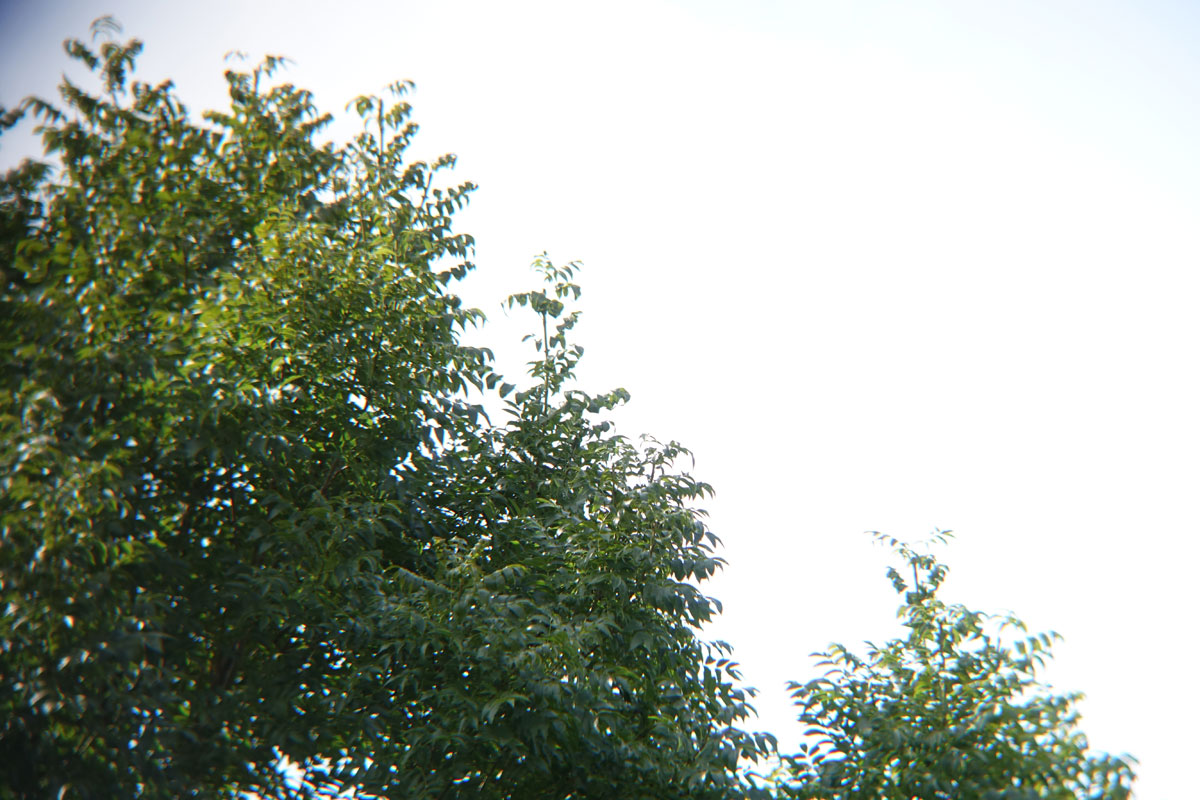 |
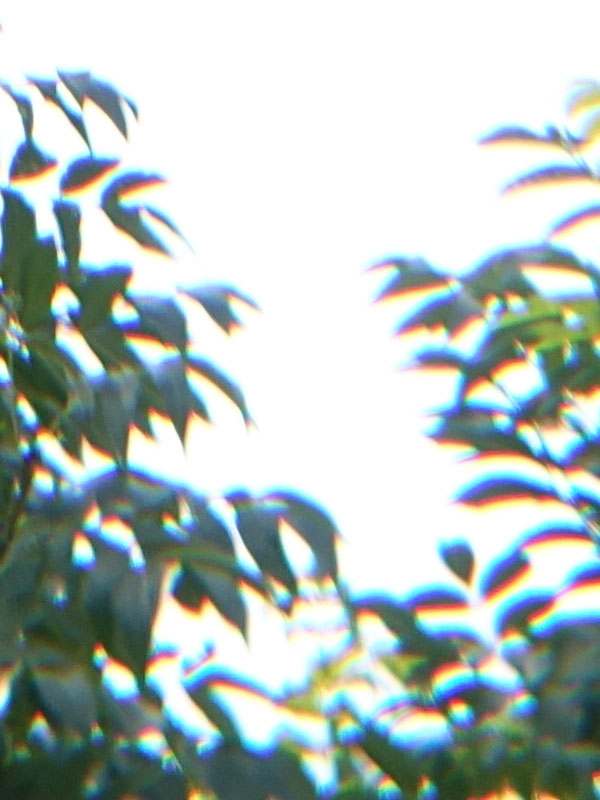 |
Figure: Sample photos with TSED35 (top row) and TSWA32 (bottom row) at the PS 72/432
Figure: Sample photos with TSED35 (top row) and TSWA32 (bottom row) at the ST120
Overall, the TSED35 may provide a somewhat sharper image, but I find this hard to judge. At first glance, I see it in the (narrow) lead... With regard to the exit pupil, however, the TSWA32 at the ST120 and also at the Explorer 150PDS with a value of 6.4 is better off than the TSED35 with a value of 7.
Comparison at Night
On our vacation in France in September 2019, I compared both eyepieces once again using the StarTravel 120 at night and was not able to see any differences, especially since I could only look through the eyepieces alternately. The TSWA32 was superior in this combination with respect to focusing, because it had room in both directions, whereas the TSED35 was "at the limit " and just came into focus. A closer inspection at home, however, revealed afterwards that there is a tiny bit of room for focusing with the TSED35.
| 07.10.2024 |
